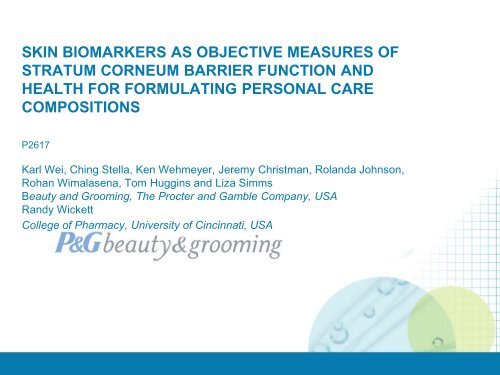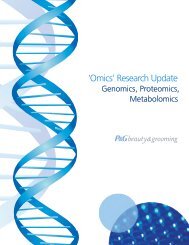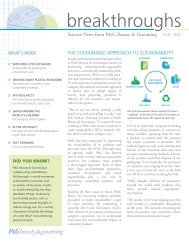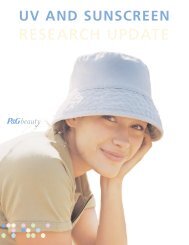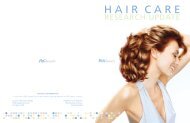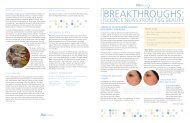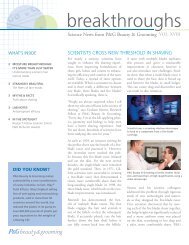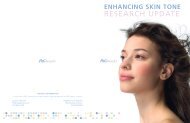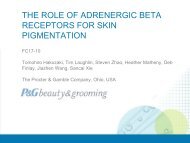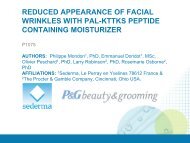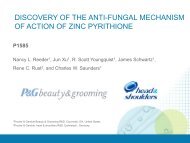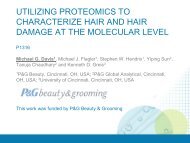Skin Biomarkers as objective measures of stratum corneum barrier
Skin Biomarkers as objective measures of stratum corneum barrier
Skin Biomarkers as objective measures of stratum corneum barrier
Create successful ePaper yourself
Turn your PDF publications into a flip-book with our unique Google optimized e-Paper software.
SKIN BIOMARKERS AS OBJECTIVE MEASURES OF<br />
STRATUM CORNEUM BARRIER FUNCTION AND<br />
HEALTH FOR FORMULATING PERSONAL CARE<br />
COMPOSITIONS<br />
P2617<br />
Karl Wei, Ching Stella, Ken Wehmeyer, Jeremy Christman, Rolanda Johnson,<br />
Rohan Wimal<strong>as</strong>ena, Tom Huggins and Liza Simms<br />
Beauty and Grooming, The Procter and Gamble Company, USA<br />
Randy Wickett<br />
College <strong>of</strong> Pharmacy, University <strong>of</strong> Cincinnati, USA
Introduction<br />
• Xerotic skin is a common skin disorder that is reflected by<br />
reduced <strong>stratum</strong> <strong>corneum</strong> hydration, incre<strong>as</strong>ed transepidermal<br />
water loss, incre<strong>as</strong>ed proliferation, decre<strong>as</strong>ed<br />
differentiation and a loss <strong>of</strong> skin el<strong>as</strong>ticity. 1-4<br />
• The condition worsens during the dry winter se<strong>as</strong>on and<br />
upon repeated usage <strong>of</strong> harsh personal cleansing<br />
products.<br />
• While moisturizing body w<strong>as</strong>h products are readily<br />
available, few purport to improve skin <strong>barrier</strong> function and<br />
health beyond traditional moisturization me<strong>as</strong>ures.
Objectives<br />
• Develop a set <strong>of</strong> skin biomarkers <strong>as</strong> <strong>objective</strong> me<strong>as</strong>ures <strong>of</strong><br />
<strong>stratum</strong> <strong>corneum</strong> <strong>barrier</strong> function and health.<br />
• Understand se<strong>as</strong>onal impact on skin biomarkers (normal<br />
healthy skin vs. xerotic skin).<br />
• Determine the impact <strong>of</strong> advanced petrolatum-depositing<br />
body w<strong>as</strong>h vs. regular personal cleansing products on skin<br />
biomarkers.
<strong>Biomarkers</strong> Indicative <strong>of</strong> Stratum Corneum Health<br />
Stratum Corneum<br />
Quality & Health<br />
Objective<br />
Biomarker<br />
Barrier Quality Keratin 1,10,11<br />
Barrier Integrity and Cohesion<br />
Total Protein<br />
Dryness Induced Irritation<br />
and Redness<br />
Hydration<br />
IL1-ra/IL1-α<br />
Pyrrolidone Carboxylic Acid (PCA)
Biomarker Sampling and Analysis Approach<br />
“Non-inv<strong>as</strong>ive sampling <strong>of</strong> <strong>stratum</strong> <strong>corneum</strong>”<br />
Sampling Sites<br />
● Leg<br />
● Arm<br />
● Targeted Multiple Analyte Assay<br />
- Multiplexed ELISA<br />
- LC/MS/MS<br />
● Colorimetric Assay for Protein<br />
- normalize targeted analyte data<br />
1) Apply D-Squame Tape 2) Remove Tape 3) Extract Analytes 4) Analysis Samples
Protocol<br />
• Standard Leg-Controlled-Application Testing (LCAT) protocol 2 w<strong>as</strong> used<br />
in this study with a minimum dryness entrance criteria <strong>of</strong> 2.0 (0-5 scale,<br />
0=no dryness) during winter se<strong>as</strong>on.<br />
• The following products were applied once a day.<br />
– Leave-on lotion containing petrolatum;<br />
– Advanced petrolatum-depositing body w<strong>as</strong>h;<br />
– Regular body w<strong>as</strong>h containing sodium laureth sulfate, sodium lauryl<br />
sulfate and cocamidopropyl betaine.<br />
• A total <strong>of</strong> ten consecutive tape strips were taken for biomarker analysis at<br />
the b<strong>as</strong>eline and at week 1, 2, and 3 <strong>of</strong> product usages, respectively.<br />
• The same panelists returned in the summer and their skin biomarkers<br />
were me<strong>as</strong>ured to understand se<strong>as</strong>onal effect.
Winter vs. Summer: Traditional Me<strong>as</strong>ures<br />
Me<strong>as</strong>ures<br />
Winter<br />
Summer<br />
P values for<br />
(n=27)<br />
(n=27)<br />
pair wise<br />
comparison<br />
Dryness (mean) 2.8 ± 0.2 1.7 ± 0.2 P
Winter vs. Summer: Keratin 1, 10, 11<br />
Keratins 1, 10, 11 higher in summer vs. winter.
Winter vs. Summer: Total Protein<br />
Total protein lower in summer vs. winter.
Winter vs. Summer: IL1-ra/IL1-α Ratio<br />
IL1-ra/IL1α ratio lower in summer vs. winter.
Winter vs. Summer: Pyrrolidone Carboxylic Acid<br />
Pyrrolidone carboxylic acid higher in summer vs. winter.
Leave-on Lotion: Pyrrolidone Carboxylic Acid<br />
35<br />
30<br />
% Change vs. Vehicle<br />
25<br />
20<br />
15<br />
10<br />
5<br />
0<br />
-5<br />
0 5 10 15 20 25<br />
Days<br />
p< 0.0001<br />
Leave-on lotion incre<strong>as</strong>ed PCA level over time.
Advanced Body W<strong>as</strong>h: Keratin 1, 10, 11<br />
%Change vs. Water<br />
200%<br />
150%<br />
100%<br />
50%<br />
0%<br />
-50%<br />
Normalized Keratin 1,10,11<br />
p
Advanced Body W<strong>as</strong>h: IL1ra:IL1αRatio<br />
50%<br />
%Change vs. Water<br />
0%<br />
-50%<br />
-100%<br />
-150%<br />
Advanced BW<br />
P
Regular Body W<strong>as</strong>h: IL1ra:IL1αRatio<br />
100%<br />
%Change vs. Water<br />
50%<br />
0%<br />
Regular BW<br />
P
TEWL vs. <strong>Biomarkers</strong><br />
TEWL Actual<br />
6.5<br />
6<br />
5.5<br />
5<br />
4.5<br />
4<br />
4.0 4.5 5.0 5.5 6.0 6.5<br />
TEWL Predicted P
<strong>Skin</strong> Biomarker Summary<br />
<strong>Biomarkers</strong><br />
Summer<br />
vs. Winter<br />
Leave on<br />
Lotion<br />
Advanced<br />
Body W<strong>as</strong>h<br />
Regular Body<br />
W<strong>as</strong>h<br />
Keratin 1, 10,<br />
11<br />
↑ ↑ ↑ =<br />
Total Protein ↓ ↓ ↓ ↑<br />
IL-1ra/IL-1α ↓ ↓ ↓ ↑<br />
PCA ↑ ↑ ↑ ↓
Conclusion<br />
• Xerotic skin showed different skin biomarker pr<strong>of</strong>ile vs. normal healthy<br />
skin (winter vs. summer).<br />
• For the first time in the rinse-<strong>of</strong>f context, the advanced petrolatumdepositing<br />
body w<strong>as</strong>h is shown to significantly improve <strong>barrier</strong> function<br />
and quality through biomarker me<strong>as</strong>ures in-vivo, similar to leave-on lotion.<br />
• Regular body w<strong>as</strong>h causes damage to skin <strong>barrier</strong> function and quality <strong>as</strong><br />
revealed by the worsening trend <strong>of</strong> most biomarkers.<br />
• <strong>Biomarkers</strong> provide <strong>objective</strong>, non-inv<strong>as</strong>ive, and consistent me<strong>as</strong>ures <strong>of</strong><br />
<strong>stratum</strong> <strong>corneum</strong> <strong>barrier</strong> function and health for guiding the development<br />
<strong>of</strong> superior personal care formulation.
References<br />
1. Engelke M, Jensen JM, Ekanayake-Mudiyanselage S, and Proksch E. Effects<br />
<strong>of</strong> xerosis and ageing on epidermal proliferation and differentiation. British<br />
Journal <strong>of</strong> Dermatology 137; 219-225 (1997).<br />
2. Ertel K, Neumann PB, Hartwig PM, Rains G, and Keswick B. Leg w<strong>as</strong>h protocol<br />
to <strong>as</strong>sess the skin moisturization potential <strong>of</strong> personal cleansing products.<br />
International Journal <strong>of</strong> Cosmetic Science 21; 383-397 (1999).<br />
3. Rawlings AV, Harding CR, Watkinson A, and Scott IR. Dry & xerotic skin<br />
conditions. In: <strong>Skin</strong> Moisturization (J.J. Leyden and A.V. Rawlings, eds), pp.<br />
119-143 (2002).<br />
4. Laden K and Spitzer R. Identification <strong>of</strong> a natural moisturizing agent in skin. J.<br />
Soc. Cosmet. Chem. 18, 351 (1967).
This work w<strong>as</strong> funded by P&G Beauty & Grooming


